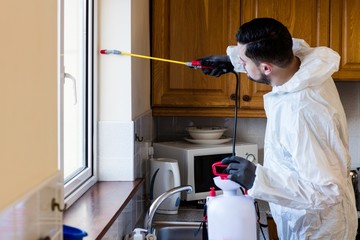Pest control is an essential aspect of maintaining a safe, healthy, and comfortable living environment. From ants and cockroaches to rodents and termites, pests can cause significant damage to homes, contaminate food, and pose health risks. Effective pest management not only prevents property damage but also safeguards the well-being of families and residents. Understanding the types of pests, prevention strategies, and available control methods is key to maintaining a pest-free home.

The Importance of Pest Control
Pests are more than just a nuisance—they can create serious problems if left unchecked. Some of the key reasons for implementing pest control measures include:
- Health protection – Many pests carry diseases or trigger allergies, including asthma, skin irritations, and infections.
- Property preservation – Termites, rodents, and other destructive pests can damage wood structures, wiring, insulation, and personal belongings.
- Food safety – Pests contaminate food with bacteria, droppings, and urine, creating health hazards.
- Peace of mind – A pest-free home reduces stress and ensures a comfortable living environment.
- Long-term cost savings – Preventing infestations reduces repair costs and avoids the need for extensive extermination efforts later.
Effective pest control protects both health and property, making it a critical component of home maintenance.
Common Household Pests
Different pests require different control strategies. Some of the most common household pests include:
- Ants – Often attracted to food and moisture, ants can form large colonies and are difficult to eliminate without targeted treatments.
- Cockroaches – Known for spreading bacteria and triggering allergies, cockroaches thrive in kitchens and damp areas.
- Rodents – Mice and rats can chew through wiring, insulation, and wood, causing structural damage and health risks.
- Termites – These wood-eating insects can silently destroy structural elements, furniture, and flooring.
- Bedbugs – Feeding on human blood, bedbugs cause itchy bites and are challenging to eradicate.
- Spiders and other insects – While some are harmless, many spiders and insects can bite, infest, or trigger allergic reactions.
Identifying the type of pest is the first step in choosing an effective control method.
Prevention Strategies
Preventing pests is often more effective than dealing with an active infestation. Homeowners can take several steps to reduce the risk of pests entering their homes:
- Seal entry points – Close gaps around doors, windows, vents, and utility lines to prevent pests from entering.
- Maintain cleanliness – Regular cleaning, proper food storage, and immediate disposal of waste reduce attractants.
- Control moisture – Repair leaks, improve ventilation, and eliminate standing water to discourage pests like ants, cockroaches, and mosquitoes.
- Inspect outdoor areas – Keep yards tidy, trim vegetation, and remove debris to minimize nesting and breeding sites.
- Regular inspections – Monitoring for signs of pests, such as droppings, chewed materials, or unusual odors, helps catch problems early.
Consistent preventive measures can dramatically reduce the likelihood of infestations.
Methods of Pest Control
Various methods are available for controlling pests, depending on the type of infestation and severity. Common approaches include:
- Chemical treatments – Insecticides, rodenticides, and other chemicals can effectively eliminate pests when used properly and safely.
- Baiting and trapping – Traps and baits can capture or poison pests, reducing populations without widespread chemical use.
- Biological control – Introducing natural predators or beneficial organisms can help manage pest populations in a sustainable way.
- Physical barriers – Screens, nets, and seals prevent pests from entering homes, particularly windows, vents, and doors.
- Integrated Pest Management (IPM) – A combination of methods, including monitoring, prevention, and targeted treatment, minimizes risks and environmental impact.
Selecting the right method requires knowledge of the pest, the home environment, and safety considerations.
DIY vs Professional Pest Control
While some minor pest problems can be addressed by homeowners, professional pest control services offer several advantages:
- Expert knowledge – Technicians can identify pests accurately and recommend effective solutions.
- Access to specialized tools – Professional equipment and treatments reach areas that are difficult to access.
- Safety – Experts handle chemicals and traps safely, minimizing risks to humans and pets.
- Long-term solutions – Professionals provide treatment plans and follow-ups to prevent re-infestation.
- Efficiency – Experienced technicians resolve infestations quickly, reducing stress and potential damage.
Professional pest control ensures thorough, safe, and lasting results.
Signs of an Infestation
Early detection is key to preventing widespread damage and health risks. Some signs of a pest infestation include:
- Droppings or urine trails
- Chewed wiring, wood, or insulation
- Unpleasant odors from pests or their nesting materials
- Sightings of live or dead pests
- Damage to furniture, walls, or stored food
- Bite marks or rashes on humans or pets
Noticing these indicators early allows homeowners to take immediate action, preventing further problems.
Health and Safety Considerations
Pests can carry bacteria, viruses, and parasites that pose serious health risks. Ensuring proper pest control safeguards residents, particularly children, elderly family members, and those with compromised immune systems. Additionally, handling chemicals, traps, and other treatments requires careful attention to safety guidelines to prevent injury or contamination.
Pest control is an essential part of maintaining a safe, healthy, and comfortable home. By understanding common pests, implementing preventive measures, and utilizing effective control methods, homeowners can protect their property, safeguard their families, and enjoy peace of mind.
Whether through regular inspections, DIY preventive steps, or professional pest control services, taking proactive measures ensures that infestations are prevented or addressed quickly. Maintaining a pest-free environment not only preserves property and health but also enhances the overall quality of life, creating a home that is safe, clean, and enjoyable for everyone.